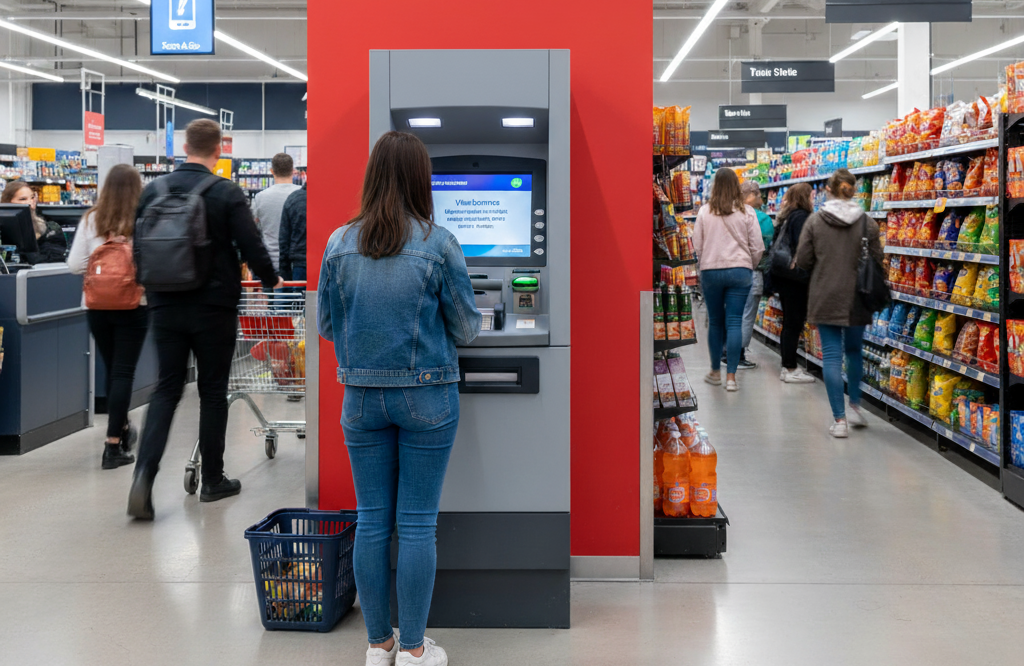Getting free access to cash shouldn’t require treasure hunting. But in the U.S., ATM fees still hit consumers hard—on average, an out-of-network ATM withdrawal can cost $4–$5 when you combine your bank’s fee and the ATM operator’s surcharge. If you’re with a financial institution that partners with a surcharge-free network, you dodge that cost. Which brings us to Allpoint, MoneyPass, and CO-OP: three of the biggest ATM networks aiming to save you those fees.
Related Article: How to Financially Prepare When Starting a Family
So: which offers the most free access? Which network is best for you—and for us, as a community bank, how do we communicate this value clearly to our customers? In this post, we'll compare Allpoint, MoneyPass, and CO-OP in depth. Let’s sort out coverage, convenience, and what to watch for—so you can maximize your free ATM access.
What Is an ATM Network (Briefly)
Before diving in: when your bank or credit union joins a surcharge-free ATM network, it means customers can use ATMs in that network without paying the usual out-of-network fees or surcharges (when using participating machines). The upside depends heavily on how many ATMs are available in the network, where they are located (near you, where you shop, travel, etc.), and whether the network supports both withdrawals and deposits (if needed).
Key Players:
Allpoint, MoneyPass, CO-OP
Here’s a snapshot of the three networks we’re comparing:
|
Network |
Approximate Number of Surcharge-Free ATMs |
Type of Institutions / Customers Served |
Highlights |
|
Allpoint |
Over 55,000 surcharge-free ATMs worldwide; more than 40,000 in retail locations in the U.S. |
Banks, credit unions, prepaid card programs; strong presence in retail – CVS, Walgreens, Target, etc. |
Great retail coverage; increasingly adds deposit-enabled ATMs (Allpoint+) |
|
MoneyPass |
About 40,000 ATMs nationwide free to participating customers (estimates vary slightly by source) |
Strong with online banks, credit unions, regional banks; many retail / convenience location ATMs plus branches. |
Good in suburban / rural areas; often used by fintechs and neobanks without branch networks. |
|
CO-OP (Co-op Solutions / CO-OP Network) |
Nearly 30,000 surcharge-free ATMs; more than 5,500 shared branches across all 50 states. |
Mostly credit unions; strong option for credit union members; shared branches add extra value. |
Shared branches (for teller-type services), deep presence in credit union community; less retail-retailer saturation than Allpoint, but strengthens in branch areas. |
How They Compare:
Free Access, Reach, Convenience
Let’s judge them by a few criteria that matter most to users:
- Geographical coverage
- Retail presence / where ATMs are located
- Deposit-enabled machines
- Network partner banks / institutions
- Ease of finding ATMs + user tools
- Hidden caveats / limits
1. Geographical Coverage
- Allpoint has the largest pool of surcharge-free ATMs in retail and non-bank locations, with over 55,000 globally and a strong U.S. footprint.
- MoneyPass is also sizable—around 40,000 ATMs in the U.S. for customers of member institutions.
- CO-OP offers nearly 30,000 ATMs, plus over 5,500 shared branches. While the ATM count is lower than Allpoint’s or MoneyPass’s, the combination of ATMs + shared branches makes it strong especially for credit union members or people who prefer branch access.
What this means for you: If you live or travel in areas with lots of retail outlets (big box stores, pharmacies), Allpoint is likely to give the broadest surcharge-free ATM access. If you’re more rural or depend more on branches (credit union or local bank), CO-OP may match or exceed in convenience once you factor shared branches.
2. Retail Presence & Everyday Locations
One of the biggest practical differences: are the ATMs where you shop or travel every day?
- Allpoint has strong placement in drugstores (Walgreens, CVS), big box retailers, and convenience retailers
- MoneyPass is found in convenience stores, select grocery stores, gas stations, in some bank branches. It tends to fill gaps for banks / credit unions that don’t have their own network.
- CO-OP ATMs are often located at credit union branches and partner retail locations (though less saturated in some national chains compared to Allpoint). The shared branch network also means that when you need teller services, you may find one.
3. Deposit-Enabled ATMs
Access to deposit ATMs makes a difference if you want full service—especially if you don’t have a branch nearby.
- Allpoint is rolling out Allpoint+, a feature that includes deposit-enabled ATMs in selected locations.
- MoneyPass: fewer machines accept deposits; it’s more common for them to be withdrawal-only. Users should check whether their institution has deposit acceptance in network ATMs.
- CO-OP: many shared branch ATMs or credit union branch ATMs do accept deposits, since credit unions often combine ATMs at branches.
4. Network Partner Institutions
How many banks or credit unions partner with each network matters—this influences whether your institution is part of it, or whether switching banks is beneficial.
- Allpoint partners with many credit unions, banks, and prepaid card issuers. Because of its retail skews, many non-traditional banks that lack large branch networks choose Allpoint.
- MoneyPass is popular among online banks / fintechs and smaller regional or community banks. If your bank doesn’t have many own ATMs, it may use MoneyPass to extend coverage.
- CO-OP is mostly credit union–oriented. If you’re a credit union member, CO-OP often is already an option. Shared branch arrangements amplify what you can do beyond simple ATM withdrawals.
5. Tools & Finding ATMs
Even the best network is only useful if you can find the participating ATM easily.
- All three networks provide locator tools (via websites and mobile apps). Allpoint’s locator is well-rated.
- MoneyPass gives good filters (withdrawals, deposits) in its maps.
- CO-OP has both ATM locators and shared branch locators. Because shared branches are less intuitively visible than typical banks, tools for locating CO-OP shared branch sites are particularly important.
6. Hidden Caveats & What to Check
No network is perfect. These are things to watch for so you really get free access:
- Even surcharge-free ATMs may have limits (daily amounts, number of free uses).
- Deposit ATMs aren’t always available in every network or at all locations.
- Some “retail” ATMs listed may be branded by retailers but operated by third parties—double-check logo and whether your bank recognizes that specific machine as in-network.
- Sometimes an ATM is in a network but doesn’t display the logo (newly added). Best practice: check via the issuer’s app or network’s locator rather than just by sight.
- Out-of-network fees vary by bank even for surcharge networks’ machines if an institution’s contract is limited.
Who “Wins”? Which Network Gives the Most Free Access
Putting together coverage, convenience, and breadth, here’s how I see the comparison:
- Allpoint is strongest for sheer number of surcharge-free ATMs especially in retail locations. If your lifestyle involves shopping at chains, pharmacies, or you travel often, Allpoint gives you more daily-life coverage. If your bank partners with Allpoint (especially with their newer deposit-capable machines), you get excellent free access.
- MoneyPass is close behind in many areas. Its strengths come when your bank is an online or fintech-bank, and you need widespread ATM options without branches. It often fills in gaps.
- CO-OP shines for people who prefer branch banking / credit unions. The ATM count is lower, but shared branches boost its utility for teller services and deposits. For credit union members, CO-OP gives a compelling deal.
In most U.S. metro or suburban areas: Allpoint likely gives you the broadest fee-free withdrawal options. But if you need deposit-capability or value having branches, CO-OP may equal or even outdo on practical coverage.
What to Do If You’re a Banking Customer
Here are concrete steps to make sure you’re getting the most free ATM access you can:
1. Check if your bank or credit union is in one (or more) of these networks
Look at your bank’s website, mobile app or ask customer support. It should list “surcharge-free network” or “partner ATMs.” If not, check Allpoint, MoneyPass, and CO-OP locators manually.
2. Map out common ATM locations in your daily life
Where do you shop? Where do you drive past often? Use network locators (or bank’s app) to see which network covers those areas. Do you frequently go to Walgreens, CVS, Target, Circle K, etc.? If yes, Allpoint might give you more convenience.
3. Check deposit functionality
If you need to deposit checks or cash, find ATMs or shared branch locations that accept deposits in your network. If your bank doesn’t offer that, you might still need to plan deposit trips to branches.
4. Watch out for ATM logos and disclaimers
Even if an ATM is physically in a participating retail store, it might not yet display the network’s logo. Sometimes signage or screen display lags changes.
5. Consider switching or opening a secondary account.
If ATM fees are a pain and your current bank doesn’t offer good surcharge-free access, a second account at a bank or credit union with Allpoint or CO-OP might make sense.
6. Take advantage of fee reimbursement features
Some banks reimburse out-of-network ATM charges up to a certain amount monthly. That helps soften the pain when free access isn’t possible.
Bottom Line
If I had to pick a “best overall” for free ATM access, Allpoint often gives the widest everyday convenience thanks to its large retail-based footprint. But “best” depends on your needs:
- If you value teller services, deposits, and branch access, CO-OP may be more useful.
- If you're digital first, often shop or travel, Allpoint (or MoneyPass) will likely give you what you need.
Always check your bank’s participation and local ATM map. Free access is great—but convenience and coverage matter just as much.


.png?width=1200&height=400&name=Personal%20Loan%20(5).png)
